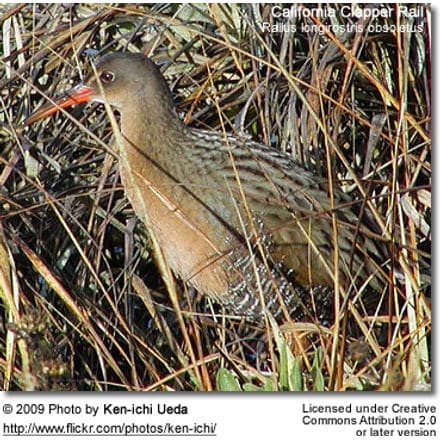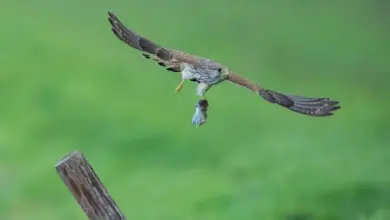California Clapper Rail
USGS California Clapper Rail Study
The California Clapper Rail (Rallus longirostris obsoletus) is an endangered subspecies of the Clapper Rail (R. longirostris). It is found principally in California’s San Francisco Bay, and also in Monterey Bay and Morro Bay. A member of the rail family, Rallidae, it is a chicken-sized bird that rarely flies.
Like other subspecies of Clapper Rail, this form has a long, downward curving bill and is grayish brown with a pale chestnut breast and conspicuous whitish rump patch. The population levels of the California Clapper Rail are precariously low due to the destruction of its coastal and estuarine marshland habitat by prior land development and shoreline fill. It has year-long, circadian activity and is most vocal nocturnally and crepuscularly (during the twilight).
Habitat
The California Clapper Rail forages at the upper end of marshes, along the ecotone between mudflat and higher vegetated zones, and in tidal sloughs. Mussels, clams, arthropods, snails, worms, and small fish are its preferred foods, which it retrieves by probing and scavenging the surface while walking. The bird will only forage on mudflats or very shallow water where there is taller plant material nearby to protect against high tide. At such high tides, it may also prey upon mice and has been known to scavenge dead fish.
The largest population of California Clapper Rails is in San Francisco Bay, where a total of about 3000 are resident. The photo above right was taken of a California Clapper Rail at the San Francisco Bay perimeter near the Dumbarton Bridge; the Don Edwards San Francisco Bay National Wildlife Refuge in the area provides protected habitats for this and other native species.
Other frequent sightings of this species around the San Francisco Bay include the Napa Sonoma Marsh, Bothin Marsh in Mill Valley, Gallinas Creek in San Rafael, Arrowhead Marsh in San Leandro, California, the Palo Alto, California baylands, Charleston Slough in Mountain View, California, Seal Slough in San Mateo and Belmont Slough.

For cover, the California Clapper Rail seeks out emergent wetlands dominated by pickleweed and cordgrass, or brackish emergent wetlands with those two plants plus bullrush. It is not clear whether it requires any source of fresh water. Although not migratory in coastal wetlands, this species disperses juveniles into freshwater wetlands in late August through October.
The California Clapper Rail has been observed to forage in or near relatively disturbed areas, leading one to deduce the importance of protecting even ruderal marsh areas; for example, this species was seen foraging in a small mudflat area within Seal Slough in San Mateo, three miles from the nearest known breeding area in Belmont.
Breeding
The California Clapper Rail breeds in the San Francisco Bay from mid-March through July, with peak activity in late June. During this breeding season the bird density was approximately 0.1 to 0.6 individuals per acre; outside of breeding season densities decline to 0.04 to 0.40 individuals per acre. The twig nest is placed low sometimes among plant roots, and three purple-spotted buff eggs are laid. Eggs are produced in clutches of four to fourteen, with an average yield of 7.6. The incubation period is 18 to 29 days, and the hatching success is 38 percent, notably less than the similar Light-footed Clapper Rail indigenous to southern California.
Comparison to some other subspecies
A close relative of the California Clapper Rail is the Light-footed Clapper Rail, Rallus longirostris levipes, a US Federal and California state-listed endangered subspecies that ranges from Santa Barbara County to the extreme north of the Mexican coast of the Pacific Ocean.
Other races of Clapper Rail are found along the east coast of North America, where populations are stable although numbers have declined due to habitat loss, the coasts and some islands of the Caribbean, and across northern South America to eastern Brazil. The Trinidadian subspecies, R. l. pelodromus, is more heavily marked with black above than any of the other Clapper Rail forms.





